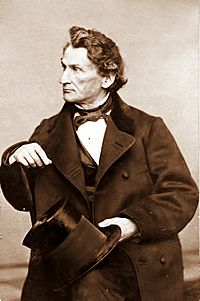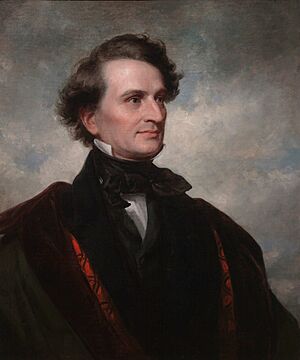James Dwight Dana facts for kids
Quick facts for kids
James Dwight Dana
|
|
|---|---|

Dana in 1865
|
|
| Born | February 12, 1813 |
| Died | April 14, 1895 (aged 82) |
| Nationality | American |
| Scientific career | |
| Fields | geology, mineralogy, zoology |
| Influences | Benjamin Silliman Amos Eaton |
| Influenced | Othniel Charles Marsh |
| Author abbrev. (zoology) | Dana |
| Signature | |
James Dwight Dana (February 12, 1813 – April 14, 1895) was an American scientist. He was a geologist, mineralogist, volcanologist, and zoologist. He made important studies about how mountains form, how volcanoes work, and how continents and oceans came to be.
His official abbreviation for naming animals is Dana.
Contents
Early Life and Amazing Journeys
James Dwight Dana was born on February 12, 1813, in Utica, New York. He loved science from a young age. His teacher, Fay Edgerton, helped him develop this interest.
In 1830, he went to Yale College. There, he studied with a famous professor named Benjamin Silliman. After graduating in 1833, Dana taught math to young sailors in the U.S. Navy. He even sailed to the Mediterranean Sea during this time.
From 1836 to 1837, he worked as an assistant to Professor Silliman at Yale. Then, for four years, he joined the U.S. Exploring Expedition. This trip, led by Captain Charles Wilkes, explored the Pacific Ocean. Dana was the mineralogist and geologist for the expedition.
His work on the expedition reports took 13 years after he returned in 1842. His notebooks were full of sketches and maps. These included drawings of Mount Shasta and Castle Crags. His sketch of Mount Shasta was published in 1849. He also wrote a detailed article about the rocks and geology of the Shasta area.
In 1844, Dana moved back to New Haven, Connecticut. He married Henrietta Frances Silliman, who was Professor Silliman's daughter. In 1850, he took over from his father-in-law. He became the Silliman Professor of Natural History and Geology at Yale College. He held this job until 1892.
Dana also became an editor for the American Journal of Science and Arts. He wrote many articles for the journal. These articles were mostly about geology and minerals.
His geology report on Mount Shasta was published in 1849. This was around the time of the California gold rush. People were very interested in finding gold. Dana was a top geologist in the U.S. He had firsthand knowledge of northern California. He had even written that gold might be found between the Umpqua River in Oregon and the Sacramento Valley. He likely received many questions about the Shasta area. This led him to publish more detailed advice for gold miners.
In 1854, he became a member of the American Philosophical Society. This is a group that promotes useful knowledge.
Studying Volcanoes in Hawaii
Dana was very important in understanding Hawaiian volcanoes. In 1880 and 1881, he led the first scientific study of the volcanoes on Hawaii Island. Dana believed that the Hawaiian volcano chain had two main lines. He called them the "Loa" and "Kea" trends.
The Kea trend included volcanoes like Kīlauea and Mauna Kea. The Loa trend included Mauna Loa and Kamaʻehuakanaloa.
After another geologist, C. E. Dutton, visited in 1884, Dana returned to Hawaii. In 1890, he published a detailed book about the island's volcanoes. This book was the best source of information for many years.
A Great Teacher
James Dwight Dana was also a much-loved geology teacher. One of his students, Oliver C. Farrington, said that learning from Professor Dana was an amazing experience. Dana always stressed the importance of being careful in scientific work. He told his students to trust authors who were careful. He did not like quick or poorly thought-out ideas.
He believed that you could learn more from differences than from similarities. This was true for both ideas and rock layers.
Dana's first teacher was also a big fan of nature. He would take his students on long walks to collect minerals, plants, and insects. This teacher helped Dana become eager to learn. Once, they collected so many minerals that they couldn't carry them all. The teacher even used his trousers as a bag to bring the specimens back safely!
James Dwight Dana passed away on April 14, 1895.
Family Life
Dana married Henrietta Silliman in 1844. Their son, Edward Salisbury Dana (1849–1935), also became a famous mineralogist.
Awards and Special Recognition
James Dwight Dana received many important awards for his work:
- The Copley Medal from the Royal Society in 1877.
- The Wollaston Medal from the Geological Society of London in 1874.
- The Clarke Medal from the Royal Society of New South Wales in 1882.
He was also the president of the Geological Society of America in 1890.
Things Named After Dana
Many places and things have been named in honor of James Dwight Dana:
- Dana Park in Albany, New York, which has a fountain and monument.
- Mount Dana and Dana Meadows in the Sierra Nevada mountains, California.
- Dorsa Dana, a system of ridges on the Moon.
- Danalite, a type of mineral.
- Dana Passage in Puget Sound, U.S.
- Dana, a crater on Mars.
- The Dana Medal of the Mineralogical Society of America. This award is given to scientists who make great contributions to mineralogy. It is named for both James Dwight Dana and his son, Edward Salisbury Dana.
- The James Dwight Dana House in New Haven, Connecticut. It was named a National Historic Landmark in 1965.
- The fossil horseshoe crab Euproops danae.
See also
 In Spanish: James Dwight Dana para niños
In Spanish: James Dwight Dana para niños
- Howlite
- European and American voyages of scientific exploration
- Dana's System of Mineralogy
- Category:Taxa named by James Dwight Dana
Images for kids



